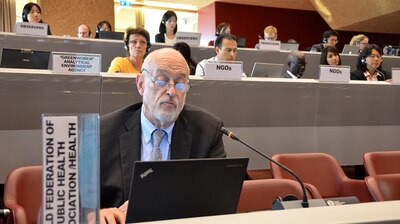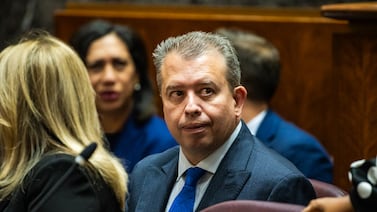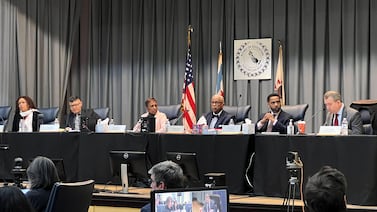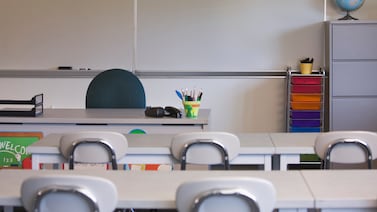As some Philadelphia teachers prepare to protest and defy orders to return to school buildings Monday, an impartial mediator has begun poring over documents to decide if schools meet safety requirements agreed on by the union and district.
One of the questions he will have to decide is whether key parts of the agreement, specifically around adequate ventilation, cover days when only staff is in the building or only become operative when students return.
The safety of Philadelphia’s aging buildings has become a key issue in the debate around early-grade students returning to school on Feb. 22 for the first time since the pandemic shuttered schools last March.
On Wednesday, Philadelphia Federation of Teachers president Jerry Jordan invoked a memorandum of agreement (MOA) the district signed last fall that dictated required safety conditions in schools before in-person learning resumes. The agreement called for hiring an independent inspector to determine whether the safety requirements were met if there was conflict around return to buildings.
As inspector Dr. Peter Orris of Chicago began his work on Friday, Jordan urged members not to show up Monday to begin preparing classrooms in part because of concerns about meeting the ventilation requirements in the MOA.

But according to the agreement, the ventilation requirements appear to be triggered when students return to classrooms. Superintendent Wililam Hite said Thursday he didn’t believe the agreement should affect teachers’ return to buildings since they will be in classrooms by themselves, though he did acknowledge that it was possible the inspector might impose additional requirements that could delay the planned reopening for students. His administration has vowed to discipline teachers who do not show up Monday.
“We think we’ve gone well beyond the requirements of the MOA,” Hite said Thursday.
It is unclear when Orris, who will do his review remotely and not visit Philadelphia, will render decisions.
“Everything is being done virtually,” city Department of Labor spokeswoman Lauren Cox said. “A mediation is never meant to be an investigation—the third-party mediator is charged with hearing from both parties and reviewing any supporting documents they provide. In this case, documents include information on inspections that have already been conducted.”
Meanwhile, some teachers and their supporters are preparing for protests Monday outside school buildings. They are planning to show up in parking lots and conduct remote learning from their cars. American Federation of Teachers President Randi Weingarten will join the union’s “day of action.”
The memorandum of agreement that Orris is charged with enforcing covers a range of issues around reopening, such as COVID positivity rates, cleaning and sanitizing, social distancing, and the use of personal protective equipment.
But it is not very detailed when it comes to ventilation requirements, an issue that has risen to the forefront in reopening discussion. And the requirements that the agreement does include — such as identifying the maximum number of occupants for each classroom — are checked off for the return of students, not the return of teachers.
A Chalkbeat analysis shows that most elementary schools appear to have sufficient classrooms to hold the number of pre-kindergarten through second grade students who are planning to return for the hybrid learning model, based on the district’s measurements of what is safe. About 9,000 pre-kindergarten through second graders out of some 32,000 have chosen the hybrid model.
But there are other issues highlighted in the reports that increasingly alarmed teachers and some parents say need resolution before schools should begin any in-person learning.
For instance, in some buildings, only a few bathrooms are usable and gyms and cafeterias are not suitable for occupancy, often because they are on a different ventilation system that is either unsafe to restart or not working at all, according to Chalkbeat’s analysis. The reports show that the Lingelbach elementary school in Germantown, built in 1955, has several classrooms with double-digit occupancy, but the cafeteria, gym, and library are safe for no people.
The MOA describes “occupied space” as not just classrooms, but libraries, gyms and cafeterias as well. (Bathrooms are dealt with separately.) Hite has said in the phased reopening, common spaces not deemed safe will not be used; for instance, students will eat lunch in classrooms if necessary, he said.
At Lingelbach, there are two usable student bathrooms on the third floor, but none of the teacher bathrooms met a standard for occupancy, according to its report, which caused some concern among parents posting on social media.
“Our children deserve clean air, functioning bathrooms, and a usable cafeteria and gym,” said a Facebook post from Friends of Lingelbach. “To be clear, parents, teachers and students REALLY want the school to open. But it is important to hold the district accountable for decades of mismanagement of our building,” the post said.
At the same time, there are parents and teachers who are eager to see a return to school buildings. Azizah Grant, the mother of a 6-year-old first grader at a charter school that hasn’t reopened and a reading specialist who works in Philadelphia schools, said “it is time to go back.” She said educators like herself should be returning to jobs just as doctors and cashiers are. “The students are failing,” she said. “The disparity is real!”
The city’s school buildings still in use have been built over more than a century, are vastly different sizes, and have several different kinds of ventilation systems. Some, like Lingelbach, have multiple systems in one building.
In at least 26 schools, the nurse’s office has been termed fit for zero occupancy.
One of these is Richard Wright elementary in North Philadelphia, where the nurse’s office is one of the inner-facing, windowless rooms in the half-century old building.
Wright principal Jeannine Payne said this is discomfiting and also a logistical problem. The nurse will have to relocate “in the middle of a health crisis,” when she will be expected to do testing and temperature-taking and other activities related to keeping everyone safe.
On social media, supportive parents were making plans to help shovel snow and make sure Monday’s protests can proceed. Snow in Philadelphia is expected to reach accumulation of more than six inches.
The principals union has also thrown its support behind the teachers union, calling for proper vetting of ventilation reports and adequate access to vaccinations. Many principals have already been working in their schools.
Johann Calhoun and Neena Hagen contributed reporting.




